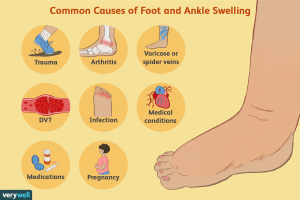Introduction
Ankles to Swell can be a discomforting mystery, leaving many individuals puzzled about the underlying causes. Whether it’s a result of standing for prolonged periods, sitting too long, or an underlying medical condition, understanding the root causes of swollen ankles is crucial for effective management and prevention. Explore More About Health Problems And Their Solutions (Contact Lenses Risk)
Understanding Swollen Ankles
Swollen ankles, medically known as peripheral edema, occur when there is an abnormal accumulation of fluid in the ankles and feet. This buildup causes the affected area to swell, leading to discomfort, restricted movement, and in some cases, pain. While occasional mild swelling may be normal, persistent or severe swelling warrants attention as it could indicate an underlying health issue.
Common Causes of Swollen Ankles
- Prolonged Standing or Sitting: Remaining in one position for extended periods can impede blood circulation, causing fluid to pool in the lower extremities, leading to swelling.
- Injuries and Trauma: Sprains, strains, or fractures in the ankle can result in localized swelling as the body responds to the injury by increasing blood flow and sending immune cells to the affected area.
- Medical Conditions: Various medical conditions such as venous insufficiency, lymphedema, kidney disease, heart failure, and deep vein thrombosis (DVT) can contribute to ankle swelling by disrupting the body’s fluid balance.
- Medications: Certain medications, including calcium channel blockers, steroids, and nonsteroidal anti-inflammatory drugs (NSAIDs), may cause fluid retention, leading to swollen ankles as a side effect.
- Pregnancy: Hormonal changes and increased pressure on the veins from the growing uterus can result in fluid retention and swollen ankles, especially during the later stages of pregnancy.

Symptoms and Diagnosis
Identifying the underlying cause of swollen ankles often involves a comprehensive evaluation of symptoms, medical history, and diagnostic tests. While swollen ankles may present as a standalone symptom, they are often accompanied by other signs such as:
- Puffiness and Tightness: The affected area may appear visibly swollen and feel tight or stretched.
- Discoloration: Skin discoloration, such as redness or bluish tint, may be observed due to poor circulation or underlying vascular issues.
- Limited Range of Motion: Swelling can restrict movement and flexibility in the ankles, making it difficult to walk or perform daily activities.
- Pain or Discomfort: In some cases, swollen ankles may be accompanied by pain, tenderness, or a sensation of heaviness in the legs.
Managing and Preventing Swollen Ankles
Effective management of swollen ankles often involves addressing the underlying cause while implementing lifestyle modifications to alleviate symptoms and prevent recurrence.
Lifestyle Modifications
- Elevate Your Legs: Elevating the legs above heart level can help reduce swelling by facilitating the return of blood and lymphatic fluid to the heart. Aim to elevate your legs for at least 15-20 minutes several times a day.
- Stay Active: Regular physical activity, including walking, swimming, or cycling, promotes circulation and helps prevent fluid buildup in the ankles. Incorporate low-impact exercises into your routine to strengthen the muscles and improve overall cardiovascular health.
- Maintain a Healthy Weight: Excess weight puts added pressure on the lower extremities, exacerbating swelling. Maintain a balanced diet and engage in regular exercise to achieve and maintain a healthy weight.
- Avoid Prolonged Sitting or Standing: Take breaks to stretch and move around if you have a sedentary job or lifestyle. If standing for long periods is unavoidable, shift your weight from one foot to the other and perform ankle exercises to promote circulation.
- Wear Compression Stockings: Compression stockings provide gentle pressure to the legs, promoting venous return and reducing swelling. Choose compression stockings with the appropriate level of compression recommended by your healthcare provider.

Medical Interventions
- Medication: In cases where underlying medical conditions contribute to ankle swelling, your healthcare provider may prescribe medications to manage symptoms and address the root cause. Diuretics, anticoagulants, and medications to improve circulation may be recommended based on your individual needs.
- Physical Therapy: Physical therapy exercises focusing on ankle mobility, strength, and flexibility can aid in reducing swelling and improving overall function. A physical therapist can develop a customized treatment plan tailored to your specific needs and goals.
- Compression Therapy: In addition to compression stockings, advanced compression devices such as pneumatic compression pumps may be prescribed to enhance lymphatic drainage and reduce swelling.
- Surgical Intervention: In severe cases where conservative treatments fail to provide relief, surgical procedures such as vein ligation, sclerotherapy, or ankle fusion may be considered to address underlying vascular or structural issues.
- Lifestyle Modifications: Incorporating stress-reducing activities such as yoga, meditation, or deep breathing exercises can help alleviate symptoms associated with swollen ankles by promoting relaxation and improving circulation.
Conclusion
Swollen ankles can significantly impact mobility, comfort, and overall quality of life if left unaddressed. By understanding the common causes, symptoms, and management strategies, individuals can take proactive steps to alleviate discomfort, prevent recurrence, and promote optimal ankle health. Remember to consult with a healthcare professional for proper diagnosis and personalized treatment recommendations tailored to your unique needs and medical history.
| Lifestyle Modifications | Medical Interventions |
|---|---|
| Elevate Legs | Medication |
| Stay Active | Physical Therapy |
| Maintain Healthy Weight | Compression Therapy |
| Avoid Prolonged Sitting | Surgical Intervention |
| Wear Compression Stockings | Lifestyle Modifications |
In summary, unraveling the mystery behind swollen ankles requires a multifaceted approach encompassing lifestyle modifications, medical interventions, and personalized care. By addressing the underlying causes and implementing preventive measures, individuals can effectively manage swelling, improve mobility, and enhance overall well-being.










